Following the departures of Erling Braut Haaland to German Bundesliga side Borussia Dortmund and Takumi Minamino to English Premier League champions Liverpool last January, many began to wonder who the next star to emerge from Red Bull Salzburg’s renowned talent factory and grab the attention of Europe’s biggest and wealthiest clubs would be.
One of the names that may well be on those clubs’ minds is Patson Daka – a 22-year-old Zambian centre-forward who has been playing for the Austrian Bundesliga side since making his move from Kafue Celtic back in 2017. He stands at 183cm (6’0”) tall, weighs 71kg (156 lbs) and is under contract with Salzburg until the end of June 2022, per Wyscout.
In this tactical analysis piece, in the form of a scout report, we’re going to provide some in-depth analysis of this exciting striker’s game and how he is used within Jesse Marsch’s tactics. This scout report will look at the main strengths of Daka’s game, as well as some potential areas of improvement, and we’ll ultimately explain exactly why we feel he’s a talent you should be keeping a close eye on in 2021.
Positioning and movement
Daka is, first and foremost, a goalscorer and a very prolific one at that, having bagged 24 goals in 31 league appearances for Salzburg during the 2019/20 campaign – an average of just over 0.77 goals per game – and having netted on an impressive six occasions in Austria’s top flight in his first six appearances of the 2020/21 season – one goal per league game.
So far, in his entire career, Daka has scored 0.64 goals per game with an xG of 0.54 goals per game, so he slightly overperforms his xG but not by an incredible amount and it may be fair to say that the numbers are relatively close.
While his finishing is generally clinical, one of the main reasons we are going to highlight for his clinical nature in front of goal is the intelligence of his movement and how he positions himself before receiving the ball creating plenty of space for himself in optimal shooting positions, giving himself the best possible opportunity to convert his chances when they do ball does find him.
Additionally, it does often seem as though the ball literally just finds him, due to how he often ends up on the end of a pass, loose ball or rebound in very favourable positions but this is a result of his excellent positioning and movement before the ball reaches him which creates such favourable conditions for the striker.
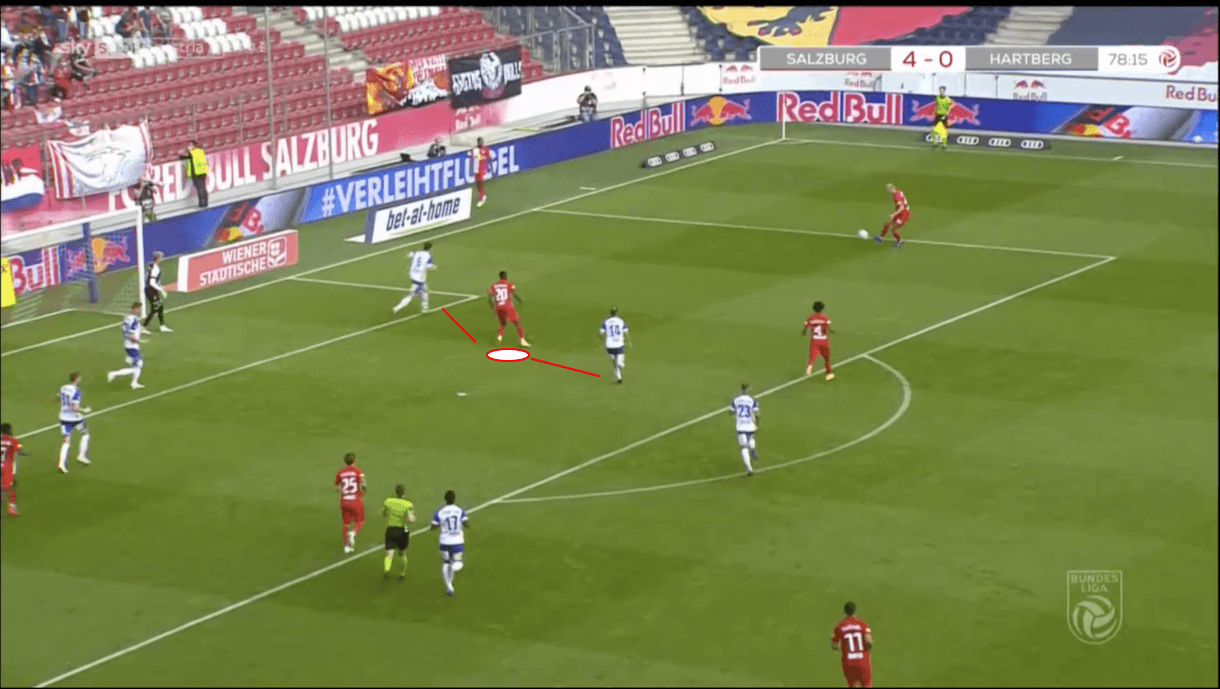
Daka is a player with a lot of tools but he is smart in how he uses or doesn’t use them at specific times. He’s quick, strong and decent at putting a low cross into the penalty area from the wing but while he’s played on the wings at times, he generally operates as a centre-forward and when doing so, his most effective trait – his ability to find space – shines and this image shows us an example of this trait of Daka’s in action.
Here, we can see the Zambian in the centre of the box and with two opposition defenders near him on either side but at a fairly significant distance. As this particular play moves on and Salzburg continue to work the ball into the centre of the box, Daka maintains a decent amount of space between him and these defenders, keeping himself in a position where if the ball finds him, he can pull off a quick one/two touch finish, which is exactly what happens.
His spatial awareness in relation to opposition defenders is excellent and he’s capable of making subtle movements inside of the box to keep himself free at the right moments to end up with the ball at his feet within the width of the goalposts.
This intelligent movement and positioning go hand in hand with intelligent shot selection when it comes to Daka. He rarely takes on long-shots, with just one of his 19 shots at goal in the league this season coming from outside of the penalty area.
The benefit to this intelligent shot selection is seen in how often he hits the target with his shots. Daka has taken 4.38 shots per 90 in the league this term, hitting the target with 57.89% of them. For reference, Haaland took 4.54 shots per 90 in the Austrian Bundesliga last season, hitting the target with 48.08% of them.
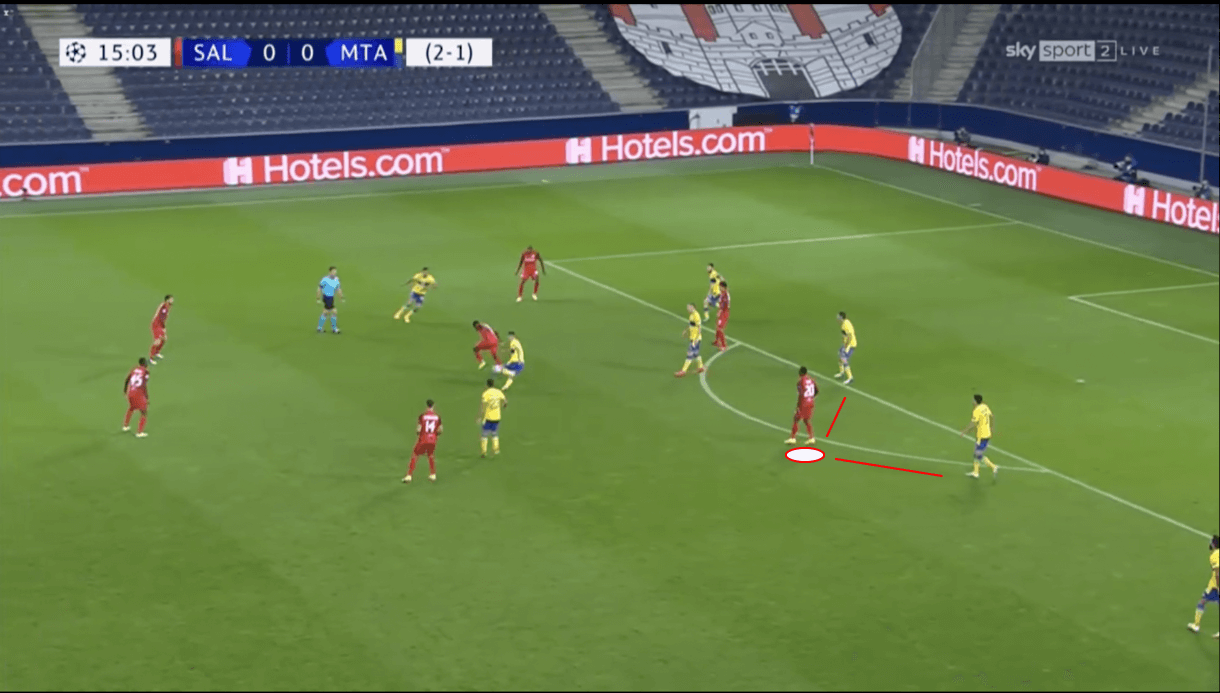
This next image shows us Daka slightly withdrawn from the opposition’s centre-backs but still in a very advanced, central attacking position inside of the final third, observing play while maintaining a distance between himself and everyone else, while his teammate is in possession in the left half-space.
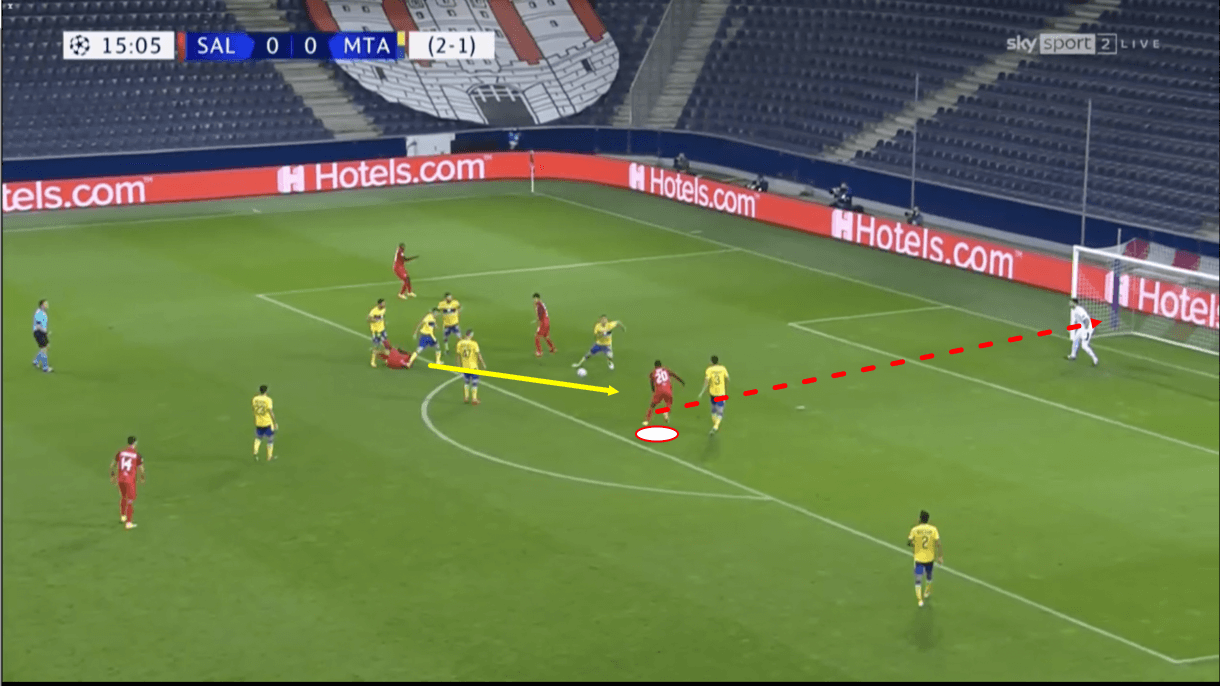
As this sequence plays out, Daka’s teammate is tackled but the ball actually ends up moving into the box. After observing the play, standing still whilst others were moving and keeping himself in space, Daka then reacts very quickly as the ball breaks away into the penalty area and is, once again, within the width of the goalmouth to tuck the ball away first time with his supposedly weaker left foot.
As well as his positioning and lightning-quick reactions – which also help him to take advantage of so many rebounds, quick low crosses and loose balls – this sequence allows us to bring up another major positive aspect to Daka’s game – his two-footedness.
The 22-year-old is very two-footed and scores almost as many goals with his left foot as he does with his right foot, the latter being his alleged stronger foot. This two-footedness makes him even more difficult to defend against, especially in these central areas he likes to position himself, as he can shoot very effectively from either side and he’s an agile dribbler that can quickly shift the ball onto either foot when a potential shooting angle opens up.
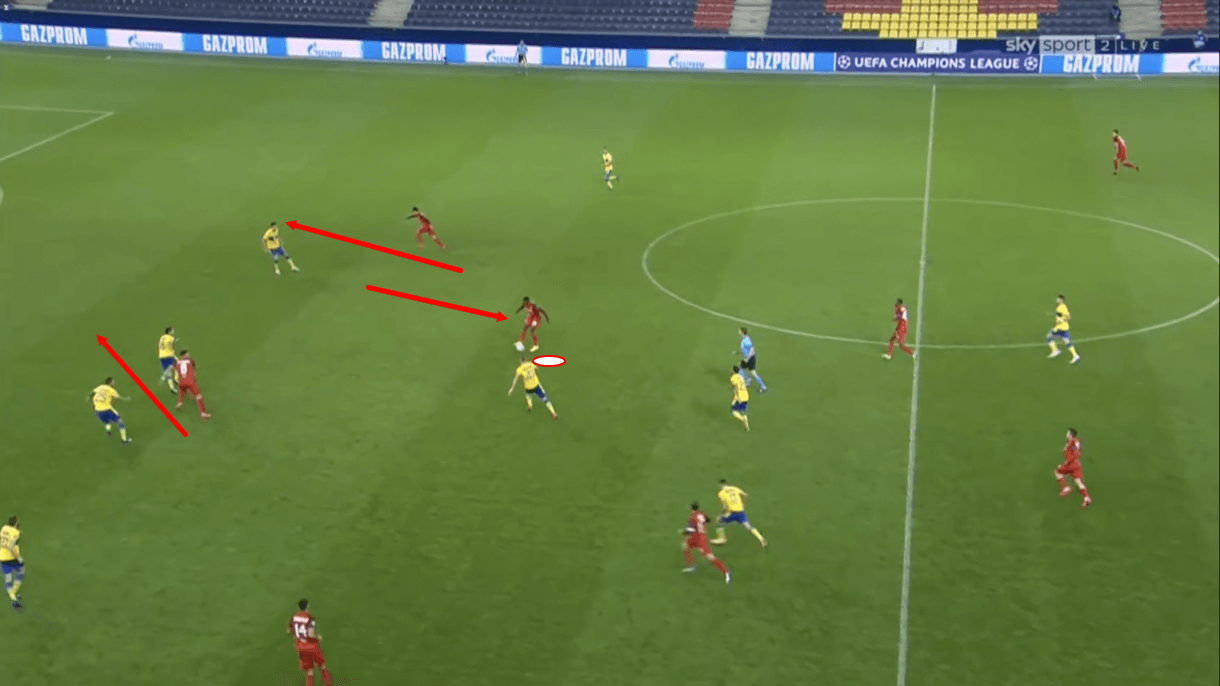
Also, when his team is playing in the middle third and building into the final third, it’s not unusual to see Daka drop off the opposition defensive line now and again. More often than not, due to his physicality and his excellent hold-up play which we’ll discuss at greater length later, Daka plays higher up the pitch but if given space by the opposition, he does drop off on occasion to collect the ball slightly deeper and when that happens, as was the case for this particular passage of play, he can show off his playmaking ability and thread a ball through to the runners ahead of him.
He’s capable of playing this role and good at finding teammates with through balls, however, all in all, you’d probably prefer to have Daka on the receiving end of a ball like this and making the run in behind, due to his finishing quality and his pace. It’s important to note, however, that he’s very versatile in terms of the role he can play and dropping deeper like this is another element to his game.
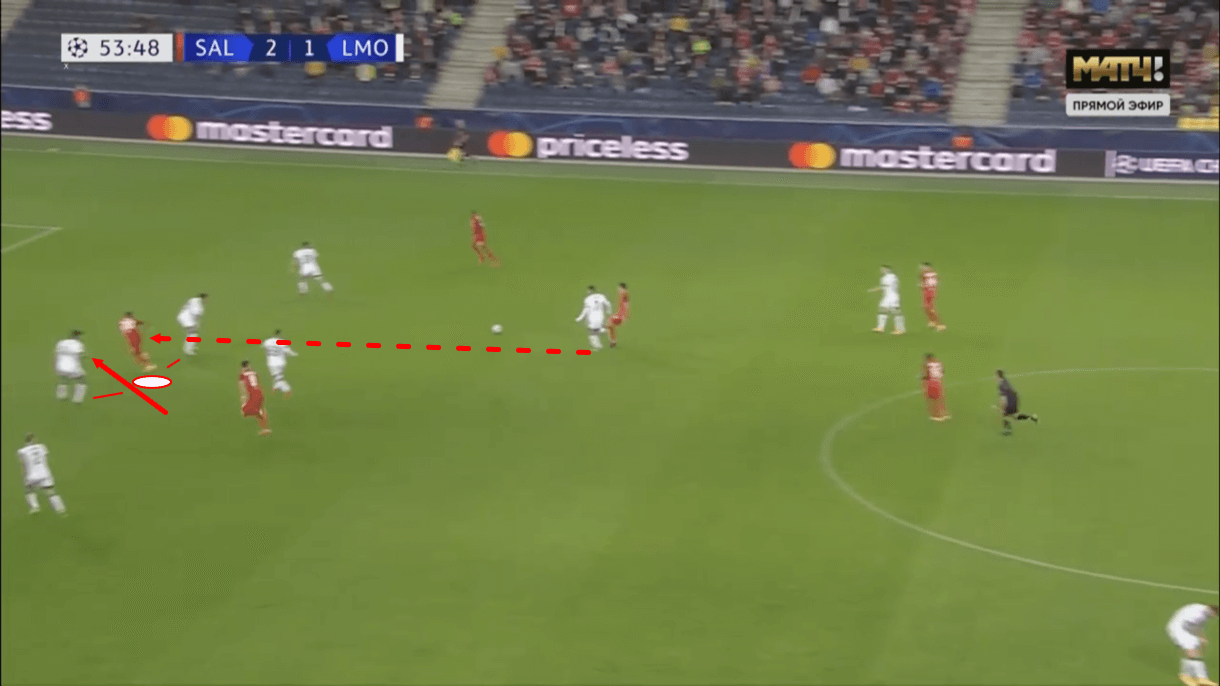
Usually, though, with Salzburg in this specific area of the pitch building into the box, this is where you’ll see Daka. On the last shoulder of the opposition defence, maintaining as much distance as possible between himself and the centre-backs, ghosting in behind off the last shoulder of the backline.
He excels in these situations when the potential to run in behind presents itself, firstly, due to his intelligent movement and ability to make a subtle, yet devastatingly dangerous run in behind, and his pace, because when he does break away and the ball is played through, he’s very difficult to catch. As a result, opposition defenders really have to be very aware of Daka’s movement at all times, which, when playing against a team like Salzburg who attack in a fast-paced style, can be difficult.
However, there is an argument to be made that due to his agility and dribbling quality, it may not be very smart to stick too tight to Daka either, as he is comfortable at playing with his back to goal and can receive, hold the ball up and either combine with a teammate to get in behind or spin around himself, using his strength and the opponent’s body to turn and end up in a 1v1 with the goalkeeper. We’ll look more at this aspect of his game in the next section.
Receiving the ball
So, how has Daka performed when playing with his back to goal versus tighter marking?
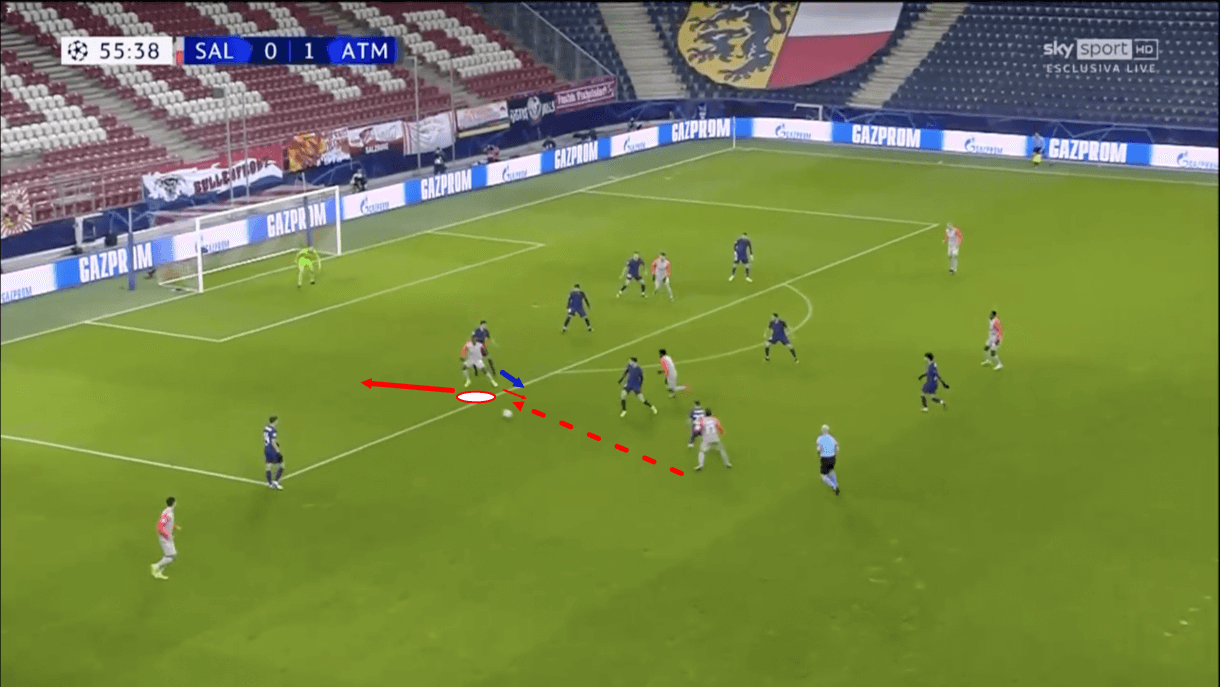
This next image provides us with an example of the forward receiving the ball in that exact situation and Daka thrives in these scenarios due to his level of dribbling ability and agility.
Daka is strong enough to back into a defender and hold the ball up in these situations, which he often does, but he’s also quick and agile enough to potentially spin out and get around the defender on his own in this type of situation.
On this occasion, Daka’s receiving the ball with one teammate running towards goal inside of him who he could potentially pass to, but with so much more space on the outside and no teammate out there, he opts to collect the ball and go alone and the Zambian reaps the benefits of this decision.
He intelligently uses his body positioning to keep the defender guessing as the pass comes to him, initially feinting forward on his left leg before quickly switching his weight onto his right leg, receiving the ball and spinning in behind, exploiting this space and creating a good shooting angle.
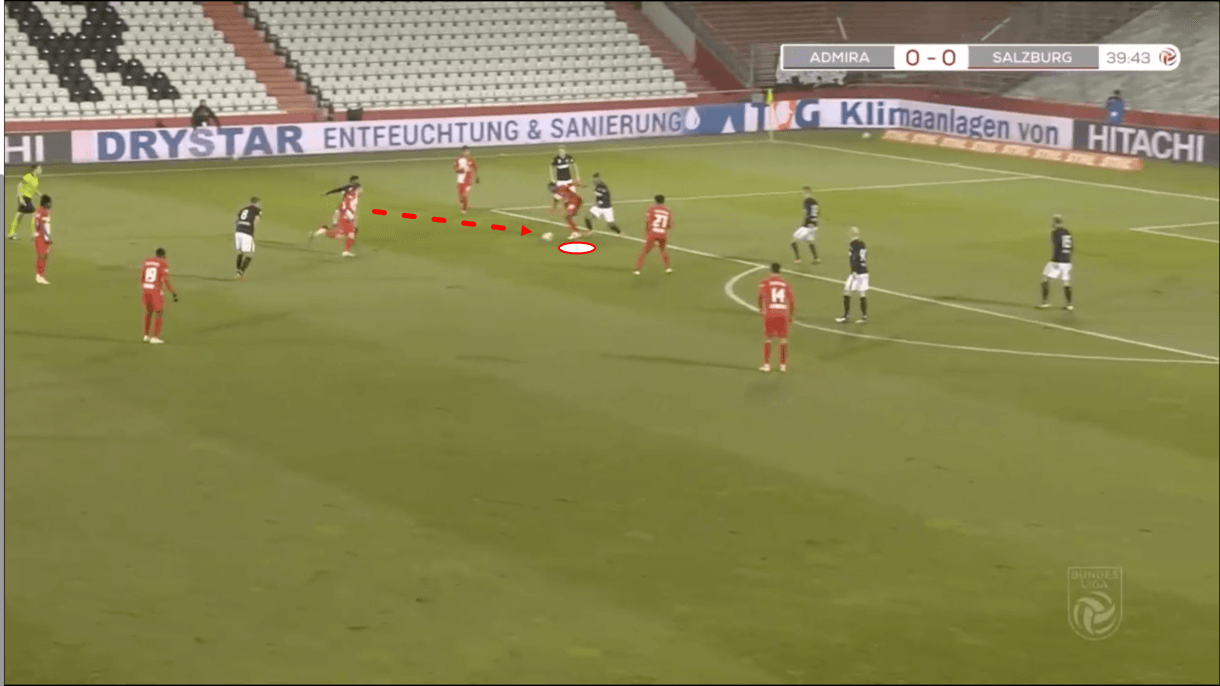
However, as mentioned, this isn’t always how he acts in these situations, his decisions depend on the conditions of the specific scenario and the fact he has so many tools available to him, as well as the fact that he does generally display very good decision making in a variety of different scenarios, helps him to be very valuable regardless of the conditions he’s receiving the ball in.
In the next image, we can see that there’s less space around him to turn and move into, so he uses his strength to hold off the defender and hold up the ball before linking up with his teammate in more space, moving towards goal. Salzburg often play the ball into Daka’s feet in these situations and he does well at holding up the ball and linking with the midfield.
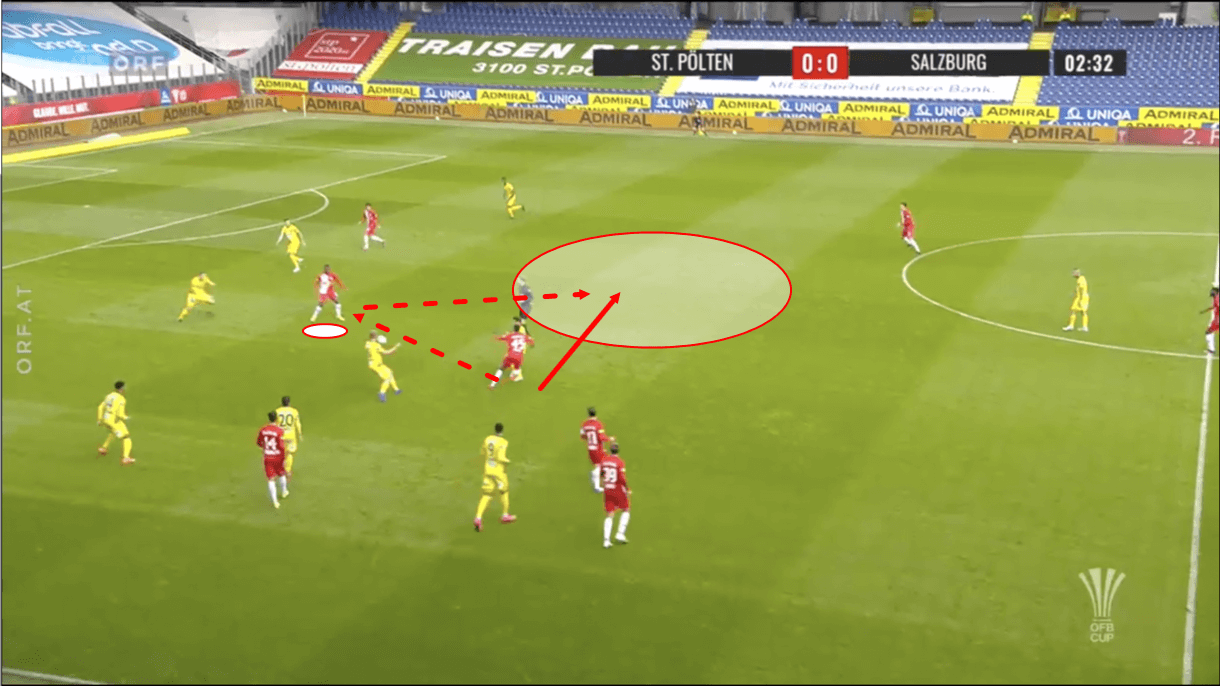
Additionally, Daka is often used by his midfielders in similar scenarios to the one we saw him in the previous image, but to quickly link up with via one-twos or to quickly circulate possession between players who otherwise wouldn’t be able to pass to one another.
With his back to goal, as seen in this next image, the forward receives but the teammate who played the pass is clearly looking for Daka to return it as he moves into the central space around the opposition defender between him and that space.
That defender prevented the midfielder from just carrying the ball into that space himself, so, instead, the Salzburg midfielder played the ball to Daka, continued his run on the outside of that opposition player, moving centrally where he can then receive the ball from Daka. The 22-year-old often performs this role for his side and it’s very valuable in terms of helping Salzburg to build into the final third and in terms of helping Salzburg’s creative players to enjoy more space.
Aerial ability
One potential area of improvement for Daka is in his aerial ability. Firstly, Daka’s aerial ability isn’t that bad.
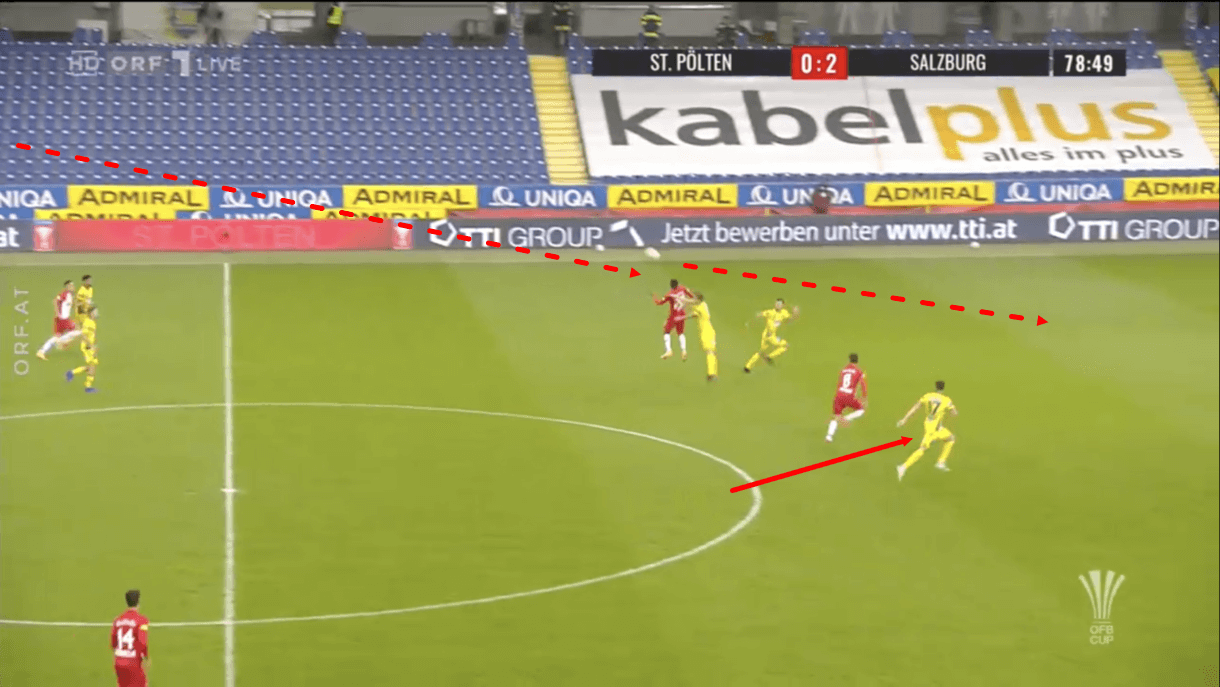
As this image shows, he’s good at being the player who Salzburg aim for to flick the ball on for a runner in behind. When Daka gets up off the ground early and times his jump well, he’s an asset, in this way, in the air. The issue is, it’s not always a sure thing that he gets up early to win the aerial duel and when he doesn’t, while he’s strong and a decent height, he doesn’t have the extreme physicality or a freakishly impressive jumping ability to make up for it, especially versus big, physical defenders.
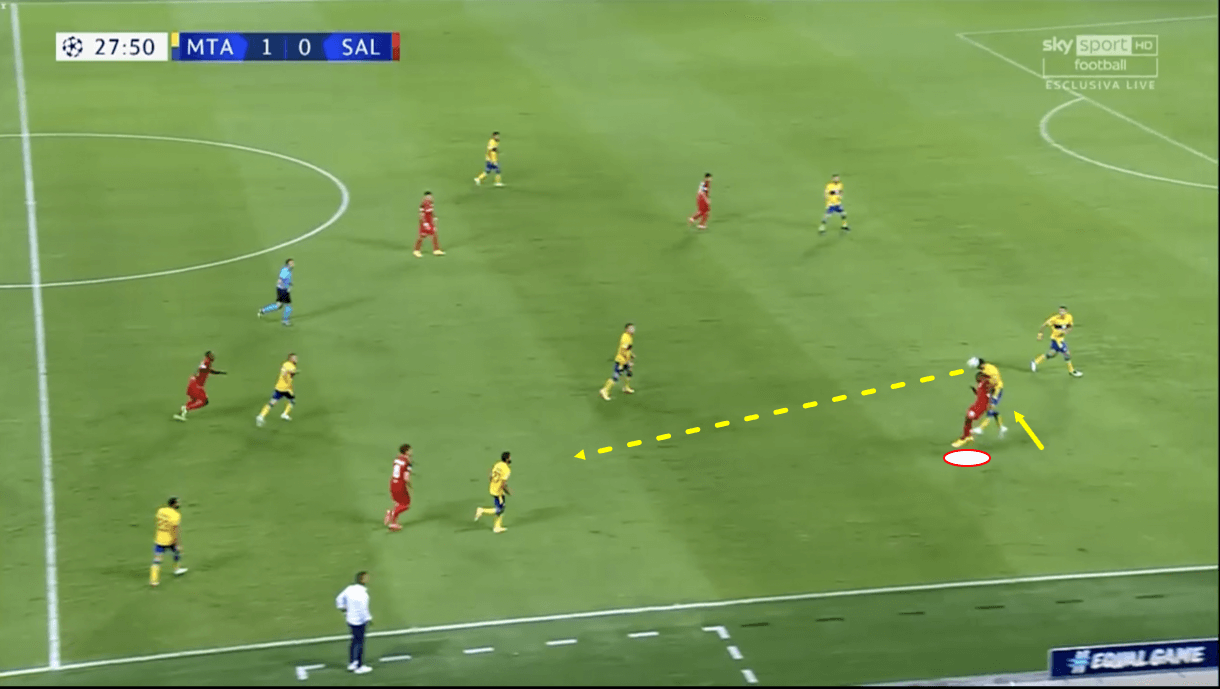
For example, this next image shows us an example of Daka being beaten in the air by a physical defender, who it may be fair to say didn’t tower over him in stature, but simply entered the aerial duel with more intensity and with more physicality. In the end, this resulted in Salzburg’s attack breaking down.
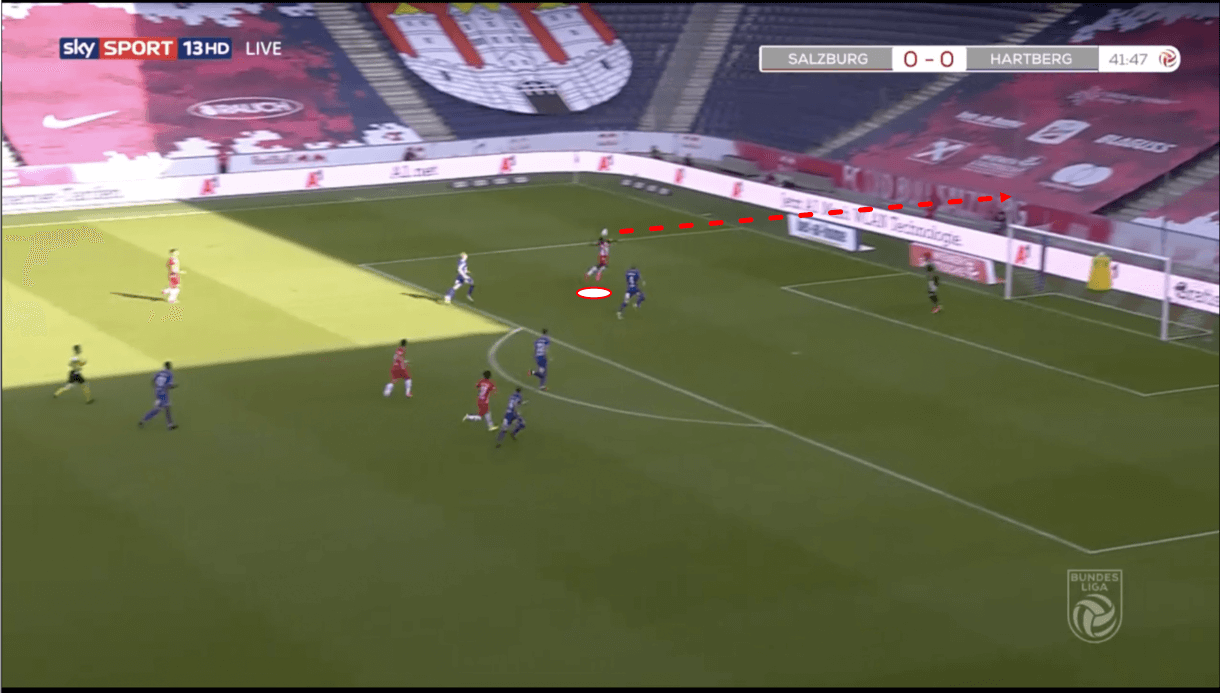
Additionally, Daka doesn’t score a lot of headers, though he does have good heading ability. One reason for this may be that he just gets outjumped or outplayed by good aerial defenders.
However, Daka is sometimes wasteful with his aerial opportunities, which the next image provides us with one clear example of.
While Daka’s shot selection and decision-making, in general, are very good, one area in which both seem to be uncharacteristically weak is in terms of his headed shots. Oftentimes, Daka is on the receiving end of poor crosses, either played too far behind him or with poor power, in which case, it would be unfair to blame him for a headed goal not being scored.
However, sometimes, despite the conditions for a headed shot not being great, for example, in this image, he’s at an angle and distance from the goal from which you might say a header being scored is unrealistic, he attempts the headed shot anyway instead of diverting from his original plan and this is an area he can improve on, as it rarely works out well.
Defensive work-rate
Lastly, we’ll touch on Daka’s impressive defensive work-rate. Daka keeps himself very active without the ball both when his team are in possession and when they’re without possession.
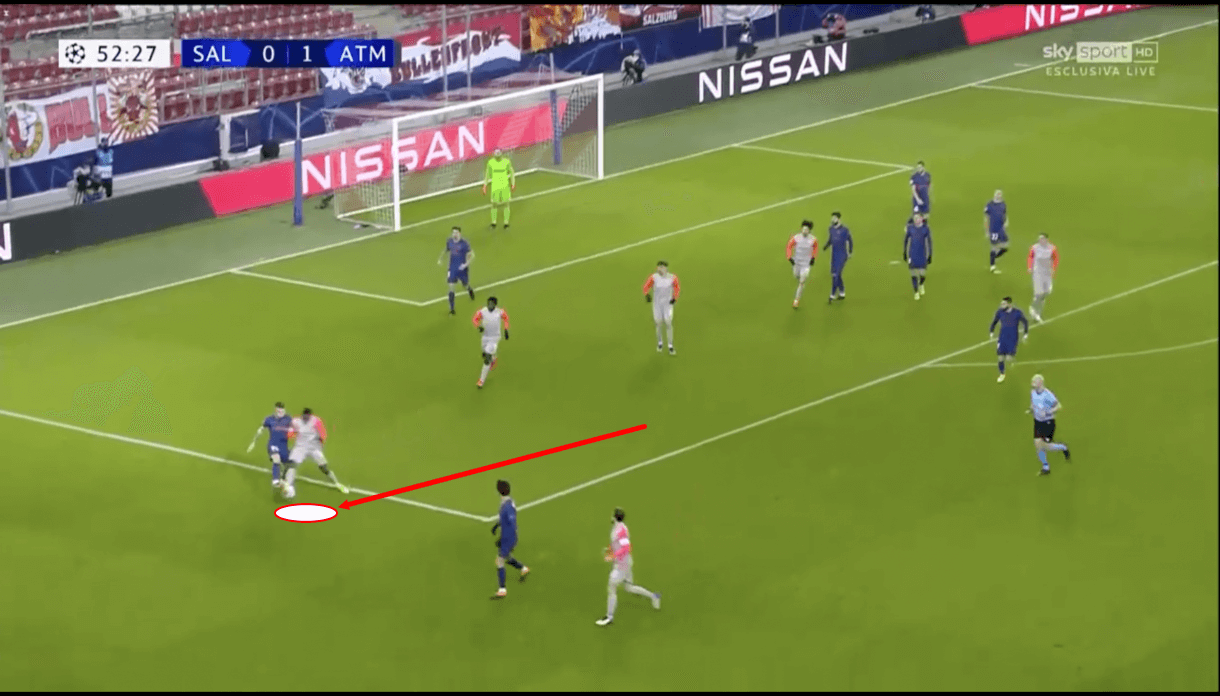
Without possession, whether he’s required to track back into deep areas or whether he’s trying to help his side to win the ball back high up the pitch, Daka generally works hard and performs his required role diligently. He could never be described as a lazy player by any means.
The image here shows us an example of the striker trying to win the ball back high up the pitch and close down an opposition player as they’re attempting to kickstart a counter-attack.
His impressive pace prevents this from happening particularly well in situations like this where he is only required to produce a short burst, however, as mentioned, he’s also diligent at helping his side to defend against a counter when the ball is further up the pitch and tracking back is not a problem for Daka, with his pace also coming in handy there.
Conclusion
To conclude this tactical analysis piece in the form of a scout report, we feel that Daka has an incredible amount of tools at his disposal and he’s very intelligent in terms of how he uses them.
He can be a major asset for any attack due to his versatile skill-set and the versatile nature of the roles that he can play.
Furthermore, he has very few major faults and we feel the upside to his game is already at an elite level, so there is no doubt that 2021 should be a big year for Daka, with his incredible ability no longer a secret.

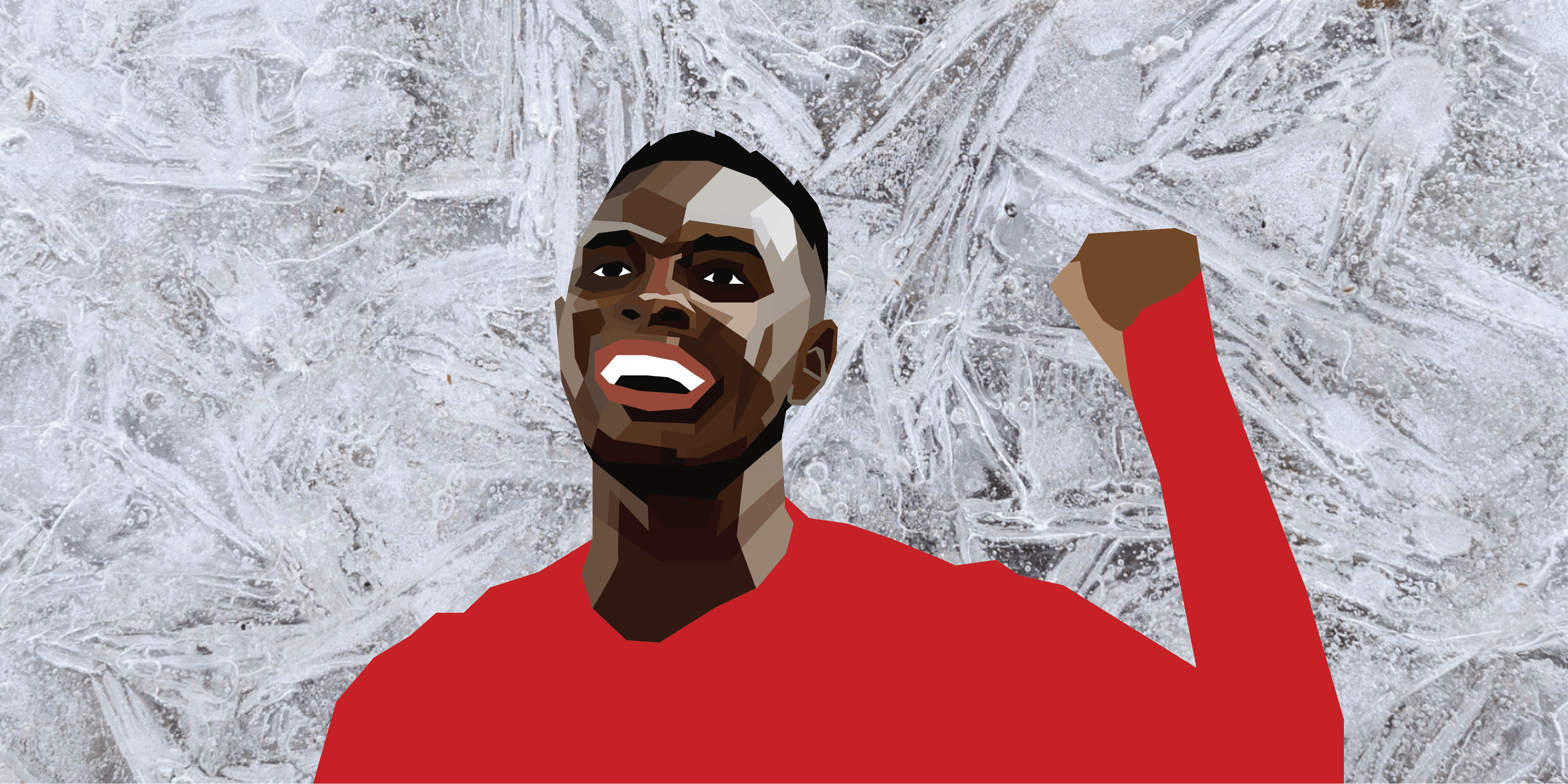



Comments